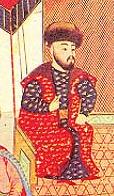| Monarchy of Crimea | |
|---|---|
| Trident of Giray | |
| Details | |
| First monarch | Hacı I Giray |
| Last monarch | Şahin Giray |
| Formation | 1441 |
| Abolition | 1783 |
| Residence | Bakhchisaray Palace |
| Appointer | Kurultai |
| Pretender(s) | Crimea</ref> Prince Aleksei Guirey [1] [ dead link ] |
| Part of a series on |
| Crimean Tatars |
|---|
| |
| By region or country |
| Religion |
| Language |
| Culture |
| History |
| People and groups |


The Crimean Khanate was a state which existed in present-day southern Ukraine (Crimea) from 1441 until 1783.
Contents
The position of Khan in Crimea was an elective monarchy and was picked by beys from four of the most noble families (also known as Qarachi beys: Argyns, Kipchaks, Shirins, and Baryns) at kurultai where the decision about a candidate was adopted. [2] The newly elected Khan was raised on a white felt sheet and over him were read Islamic prayers, after that the Khan was triumphantly enthroned. [2]